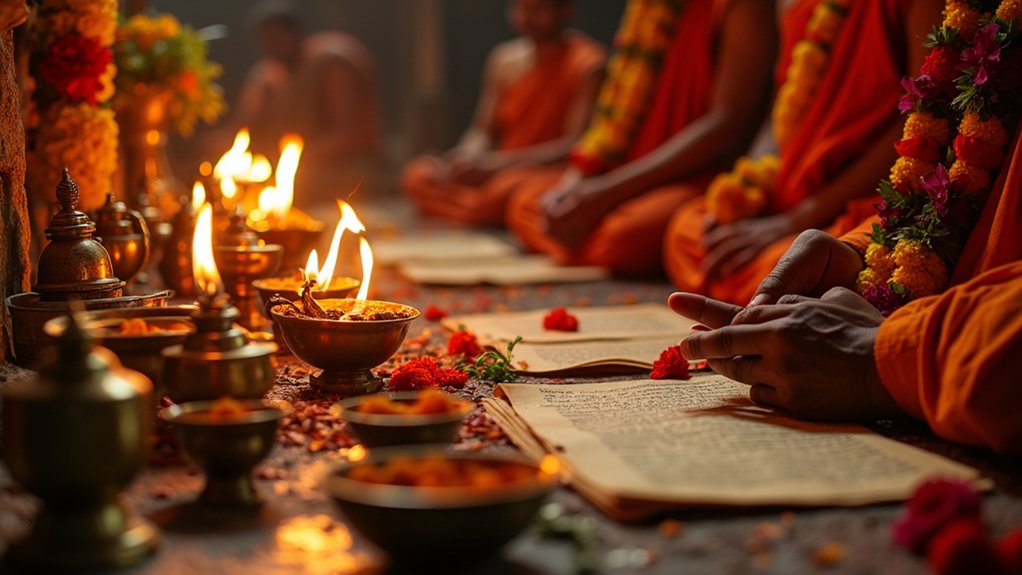
Did you know how old is Hinduism?
Fascinating insights into the age of Hinduism reveal its profound depth; discover the surprising truths that redefine this ancient faith's significance.

Vedic rituals offer a fascinating window into ancient spirituality, revealing how symbolism, procedure, and theology work together in sacred practice. Through a comparative analysis of Vedic rituals across the Rigveda, Yajurveda, and Atharvaveda, we see clear differences in the use of fire offerings, the role of Soma, and the structure of mantras. These insights help us understand how Vedic rituals shaped priestly duties, spiritual communication, and the evolving meaning of sacrifice in early Indian tradition. While scholars continue to debate the deeper implications, exploring Vedic rituals highlights enduring themes of devotion, cosmic order, and the transformative power of sacred words.

The Soma rituals are central to Vedic religion and appear throughout the Rigveda, Yajurveda, and Atharvaveda. While the core symbolism of Soma points to divine power and a cosmic link, each text shows variations in how the ceremonies are performed and understood. These differences reveal how early Vedic spirituality adapted to new contexts, roles, and meanings over time.
In the Rigveda, Soma rituals focus on praise, sacrifice, and direct communion with the divine. The Yajurveda emphasizes precise liturgical actions, showing how priests refined the practice to ensure sacred order.
The Atharvaveda adds a more practical and healing dimension, connecting Soma to protection and daily well-being. Across these sources, Soma rituals remain a unifying thread, reflecting evolving theology, ritual expertise, and the search for spiritual connection.
Fire sacrifice (Agni) practices in Vedic tradition show how central fire was to religion and spirituality in ancient India.
In early Vedic times, priests used simple fire altars and basic tools, calling on Agni to carry prayers to the gods, especially during Soma rituals.
Over time, fire sacrifice (Agni) practices became more complex, with carefully designed altars, precise measurements, and specialized instruments that reflected deeper ritual meanings.
This shift reveals how fire sacrifice (Agni) practices evolved from simple offerings to highly structured ceremonies, highlighting Agni’s lasting role as the sacred bridge between humans and the divine.
Rigveda and Yajurveda mantra recitations play a central role in Vedic spirituality, but they differ in style and purpose.
The Rigveda is known for its melodic and poetic mantra recitations, designed to deepen spiritual resonance and inspire devotion. In contrast, the Yajurveda features precise and formulaic mantra recitations that support accurate performance of rituals and ceremonies.
Together, the Rigveda and Yajurveda show how Vedic tradition balances poetic expression with procedural accuracy, offering seekers a holistic path that honors both spiritual experience and disciplined practice.
In Vedic rituals, the ritual roles of priests are clearly defined to balance spiritual and practical duties. The Hotri priest leads the sacred recitation, chanting Rigvedic hymns to invoke divine presence and maintain the ritual’s spiritual flow.
By contrast, the Adhvaryu priest manages the hands-on aspects: preparing the altar, measuring spaces, and handling offerings to ensure the ceremony is performed correctly.
This distinction between Hotri and Adhvaryu roles highlights how the ritual roles of priests work together—uniting prayerful devotion with precise action—to strengthen the power and integrity of Vedic worship.
Through this harmony of responsibilities, the ritual roles of priests support both spiritual intention and flawless execution.
In these sacred rituals, the offerings in Vedic sacrificial ceremonies represent more than material gifts—they act as bridges between the human and divine realms. Each offering aligns with cosmic principles, symbolizing elements like fire, water, and life energy, which reflect the universe’s order and the soul’s journey.
The spiritual significance of these offerings lies in creating harmony between worshippers and deities, supporting prosperity, protection, and inner balance. Through precise, meaningful exchanges, Vedic sacrificial ceremonies help practitioners cultivate devotion, maintain cosmic balance, and deepen their spiritual connection.
The comparative analyses of Vedic rituals offer a clear view of how sacred practices evolved across the Rigveda, Yajurveda, and Atharvaveda. These studies explore the roles of Soma and Agni, the power of mantra recitations, the duties of priests, and the meaning behind symbolic offerings. Through comparative analyses of Vedic rituals, we see both shared foundations and subtle differences that reflect changing spiritual priorities over time. Most importantly, these comparative analyses of Vedic rituals highlight how ceremony served as a bridge between humans and the divine, sustaining a cohesive spiritual framework in ancient Indian religious tradition.

Fascinating insights into the age of Hinduism reveal its profound depth; discover the surprising truths that redefine this ancient faith's significance.

Fasting during Ramadan fosters spiritual growth and community, but what deeper meanings and traditions lie beneath this sacred month? Discover the essence of Ramadan.

Buddhism's ancient roots in India reveal profound truths about suffering, but what led to its remarkable spread across cultures and time? Discover the journey.

Keen to understand the contrasting beliefs of Hinduism and Buddhism? Discover how their unique paths influence millions today.

In exploring the Four Noble Truths, you'll discover insights that could reshape your life, but how can these teachings truly transform your everyday challenges?

The origins of Hindu beliefs are complex and multifaceted; discover how influential figures like Vyasa and Patanjali shaped this rich tradition.